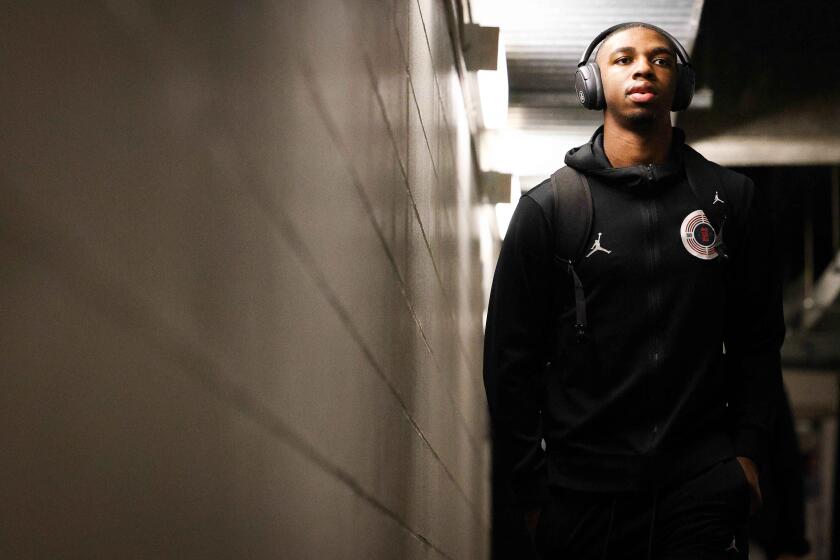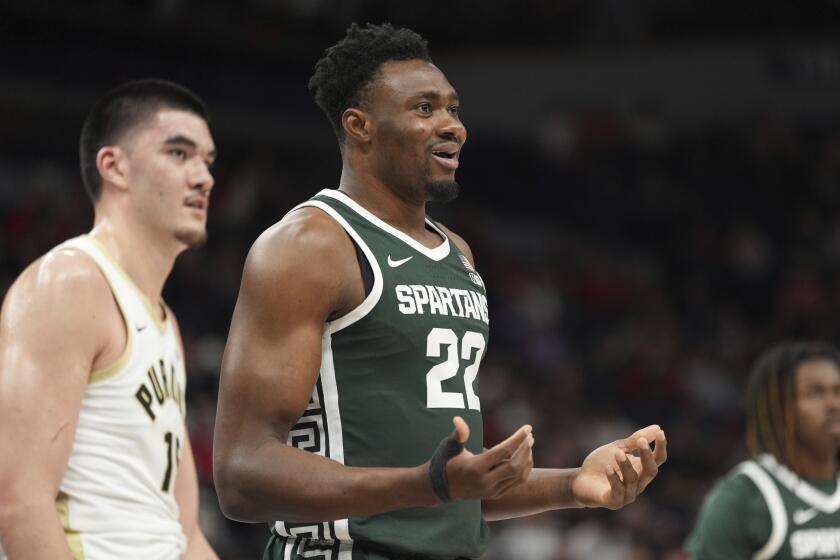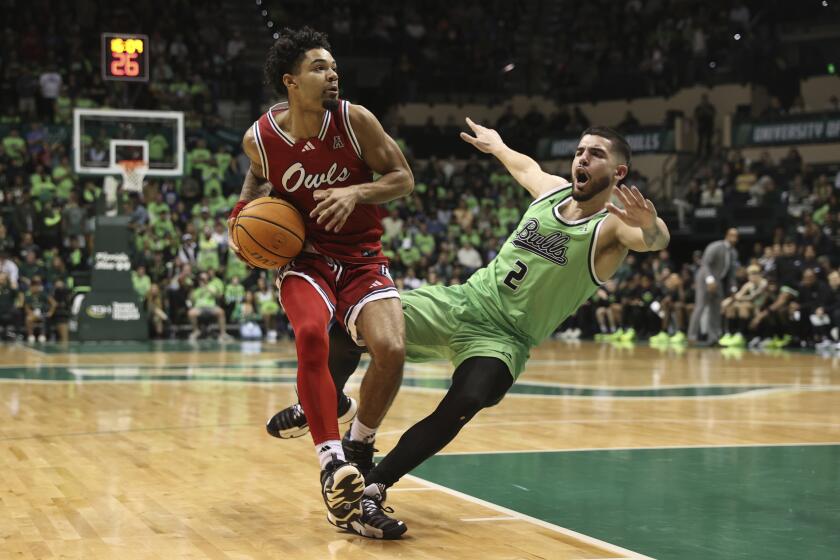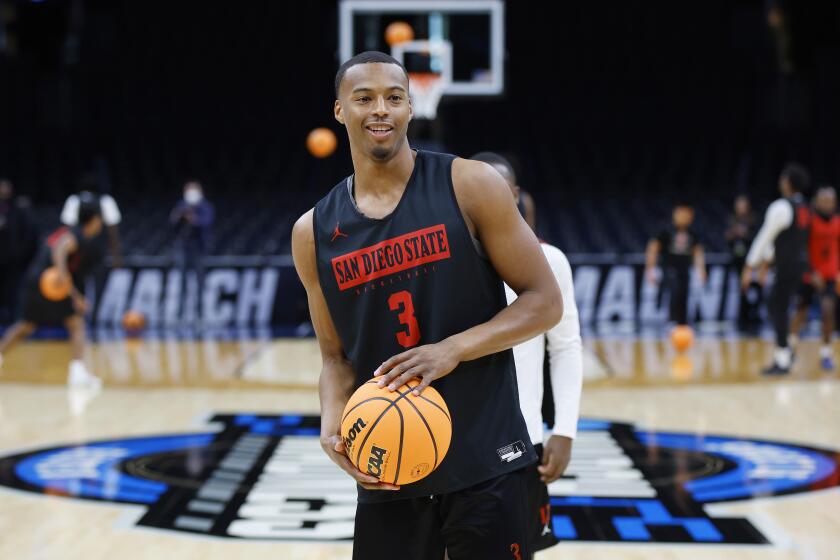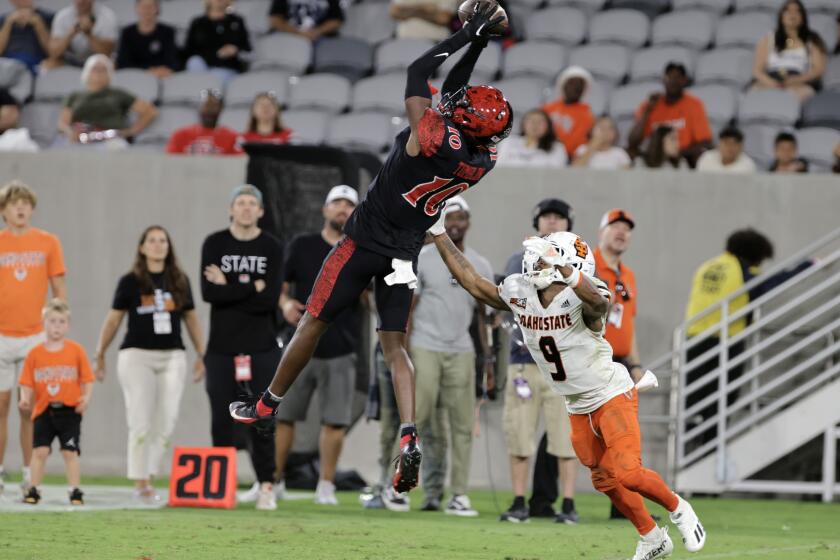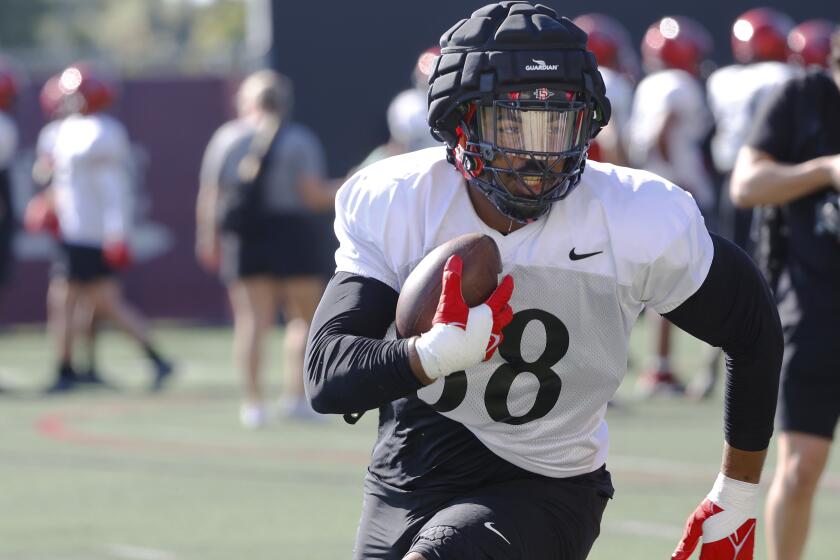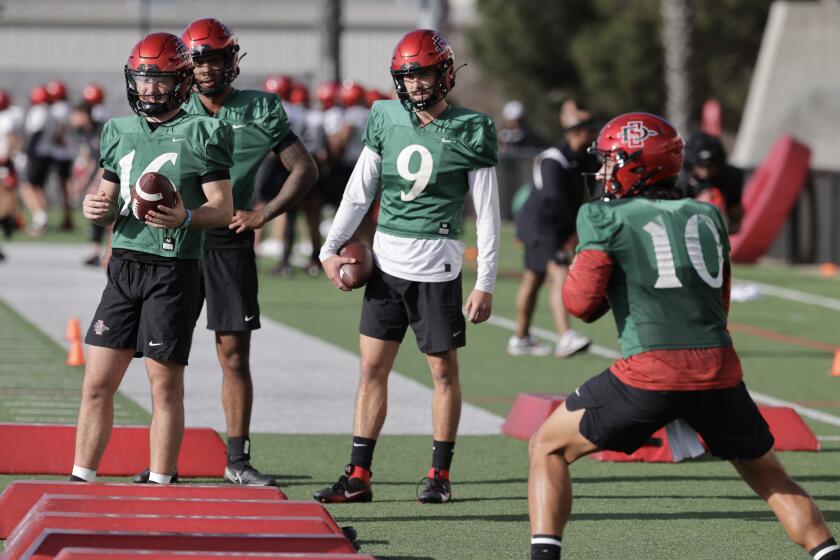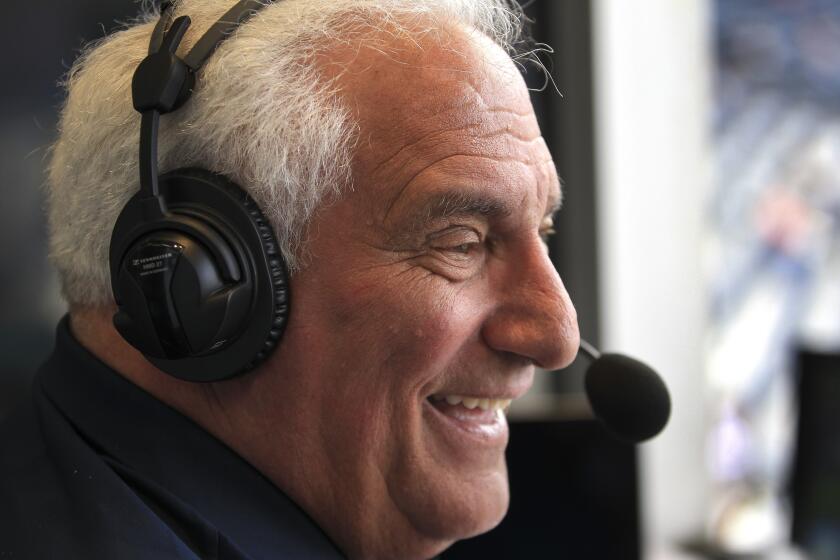The same, old Kawhi Leonard
The NBA’s Larry O’Brien Trophy is 2 feet high, weighs 14.5 pounds and is made of silver with a 24-karat gold overlay – a life-sized basketball gracefully tumbling into a net. As 2014 NBA champions, the San Antonio Spurs sent it on a world tour this summer, allowing each member of its international roster to do with it what they want for three days.
It went to a family barbeque with Manu Ginobili in Bahia Blanca, Argentina, then a music festival with Matt Bonner in New Hampshire, then a seven-day, six-city tour with Patty Mills and Aron Baynes in Australia that included a trip to the remote Torres Strait Islands between the country’s northern tip and Papua New Guinea.
Then a parade with Danny Green in North Babylon, N.Y.
Then a 3-on-3 tournament with Tiago Splitter in Barueri, Brazil.
There are stops in Canada (Cory Joseph), Italy (Marco Belinelli) and France (Tony Parker and Boris Diaw), but first 6-foot-7 San Diego State alum and NBA Finals MVP Kawhi Leonard got “Larry” for three days in Southern California. He had it Thursday, Friday and Saturday, and he arranged for people to take pictures with it at his annual skills camp for youths last weekend in his hometown of Moreno Valley.
And Thursday and Friday?
It sat in the living room of the San Diego condominium he rents during the offseason while the Spurs staffer who chaperones the trophy around the world lounged at a UTC hotel pool … while Leonard was at his three-a-day workouts.
“I didn’t have any time to do anything with it,” Leonard explained. “My workout schedule is crazy.”
Translation: He’s not missing a mid-August workout for a season that begins in late October to show off a shiny 2-foot, 14.5-pound trophy with a 24-karat gold overlay.
“I’m just a low-key guy,” he said. “I’m just happy we won it. I don’t even care about the trophy. The title matters the most.”
Which, of course, is a major reason the Spurs have it.
Leonard was speaking from the parking lot of the Moreno Valley Recreation Center after his camp last weekend. Former SDSU teammates Jamaal Franklin and Jeremy Castleberry were there, too, wearing T-shirts that Nike’s Jordan Brand had specially made to commemorate the finals MVP and that say across the front: “Unknown, unexpected, undisputed.”
Leonard was just wearing a plain, white T-shirt with a tiny Air Jordan logo.
“He’s still the same, quiet, shy guy – just always in the gym, always wants to be in the gym,” says D.J Gay, the point guard during his two years at SDSU who directed the drills at the one-day camp for 80 kids from Moreno Valley and Riverside. “I asked him if he had any time to have fun. He said, ‘I had a little fun when I came back (to California), but now I’m back in the gym two or three times a day.’
“That’s just who he is, you know ... The things that make him happy are the things that improve him as a player. It’s not the money, the fancy cars, that’s not what makes him happy. Being in the gym, working out, being able to compete every night against the best players in the world, that’s what makes Kawhi happy.”
You can take Gay’s word for it, or you can look at the mileage on the Porsche in his garage in San Antonio. Leonard arrived in San Antonio with the silver Chevy Malibu he drove in college, and friends and family finally convinced him that he needed to drive something more, ahem, befitting of an NBA player. So he bought the Porsche.
He drives it to games at San Antonio’s AT&T Center. He drives the Malibu everywhere else.
“It’s paid off,” Leonard said. “I don’t have a car note on it. It’s good on gas. It’s a good commuter car if you don’t want to drive your luxury car.”
Gay nodded.
“That’s,” he said, “why he’s as good as he is.”
That’s also why Leonard, who turned 23 on June 29, should be very rich very soon. He is entering the final season of a four-year rookie contract that pays him $2.89 million in 2014-15, numbers determined by his No. 15 position in the 2011 draft. The Spurs have until Oct. 31 to negotiate an extension, but if they want to lock him up for five years – the longest allowed – they have to offer a “max contract” based on the projected salary cap in future seasons. That computes to $89 million, give or take.
And so the game within the game begins.
Leonard’s aunt, Cheryl Walker-Robertson, is the founder of Protocol International, a company that teaches etiquette in the business world. She spoke to campers last weekend about the importance of eye contract and a firm handshake, and added this: “How many of you know that basketball is also a business?”
The Spurs recently signed point guard Tony Parker to a three-year, $43.3 million extension, leaving Leonard as the only major unsigned piece of the NBA champs. If they don’t reach a deal by Halloween, they must wait until the end of the season, when Leonard would become a restricted free agent and get offer sheets from other clubs. The Spurs, though, can match any offer.
Take 6-8 Utah Jazz forward Gordon Hayward, who was taken six spots higher than Leonard a year earlier. He rejected a four-year deal worth last year an estimated $46 million, became a restricted free agent this summer and received a four-year, $63 million “max contract” offer from Charlotte. The Jazz matched it, and Hayward remains in Utah.
But there’s risk in waiting, particularly with the gruesome images of Paul George’s crumpled right leg still fresh and raw. You wait with the intention of matching an offer sheet, and maybe your budding superstar – the guy who you went 54-12 last season with him in the lineup (including 19 straight wins after he returned from a hand injury) and 8-8 without, the guy who throttled LeBron James in the finals, the guy whom coach Gregg Popovich called the future “face of the Spurs” – becomes bitter.
Maybe he doesn’t want to stay. Maybe he demands a trade like James Harden did at Oklahoma City.
Leonard’s agent, Brian Elfus of Carlsbad, declined comment “out of respect for the Spurs and the process.” Spurs general manager R.C. Buford told the San Antonio Express-News: “There are strategic reasons to do it now or don’t do it now. There’s nothing that requires it to be done. We’ll always do what’s best for our team, and what’s best for our player.”
So Leonard waits, and works out.
He took a day off last weekend for his third annual skills camp in Moreno Valley, which is free to kids from what can be a rough area. Leonard lived about four miles from the rec center through his sophomore year of high school; later that night after his camp, about two miles away, a house party gone awry resulted in gunshot wounds to eight people, several of them adolescents.
“I mean, just for the kids to see me and see an NBA player in front of their faces is a great experience for them,” Leonard said. “When I was growing up, I didn’t have a hometown hero.”
He participated in passing and dribbling drills. He won a playful shooting contest where he and Franklin each picked a camper as a partner (Leonard, without warming up, didn’t miss a 3). He took the microphone in his 9¾-inch hand and answered questions from the boys and girls sitting in rapt silence at his feet, wearing reversible black and grey No. 2 jerseys with “LEONARD” across the back.
How hard was it to guard LeBron James in the finals?
“You know when you don’t want to run that extra lap? Harder than that. But it was worth it.”
What do you do away from basketball?
“When I’m away from basketball, I hang out with my friends, chill, and that’s about it.”
An 8-year-old girl with a pink top under her oversized jersey stuck her hand in the air. Was playing in the NBA always your dream?
“I played basketball when I was little because it was fun for me. It still is now. I just love it. I have a passion for it.”
Then Leonard walked to the far end of the court and patiently posed for photo after photo with the Larry O’Brien Trophy emblematic of the ultimate team triumph. (The Bill Russell trophy as finals MVP was conspicuously absent.)
“I always forget how much money he has,” said Castleberry, his closest friend from high school and college who recently was hired by the Spurs in their video and player development unit. “You forget because he doesn’t live like that. He doesn’t splurge.
“The money is a great thing, but he never, ever once talked about it, like: ‘I want to do this so I can get rich.’ It was always: ‘I want to be the best player in the NBA.’”
Kim Robertson stood in the corner and watched the campers mesmerized by her son. This was her idea, holding it in Moreno Valley, making it free, respecting your roots, giving back.
“Money does change people, but so far it hasn’t changed him and hopefully it doesn’t,” Robertson said. “I guess it’s just who he is, his personality. He doesn’t want anything. He doesn’t really like to spend money.”
For his first three years in the league, they lived together in a two-story home in San Antonio, the NBA player upstairs, the mother downstairs. The idea was that he was 19 when he was drafted after his sophomore year at SDSU, and she wanted to ensure her baby had to worry about only playing basketball, not what he was eating for dinner or how much detergent to pour in the washing machine.
They mutually agreed it is time to find separate places and they have started looking elsewhere, partly a function of adulthood, partly a function of geography.
Their current house is 15 minutes from the Spurs practice facility northwest of downtown, maybe 20 with traffic. Too far. Leonard wants to be five minutes away.
“I’m trying,” he said, “to be closer.”
Sign up for U-T Sports daily newsletter
The latest Padres, Chargers and Aztecs headlines along with the other top San Diego sports stories every morning.
You may occasionally receive promotional content from the San Diego Union-Tribune.

